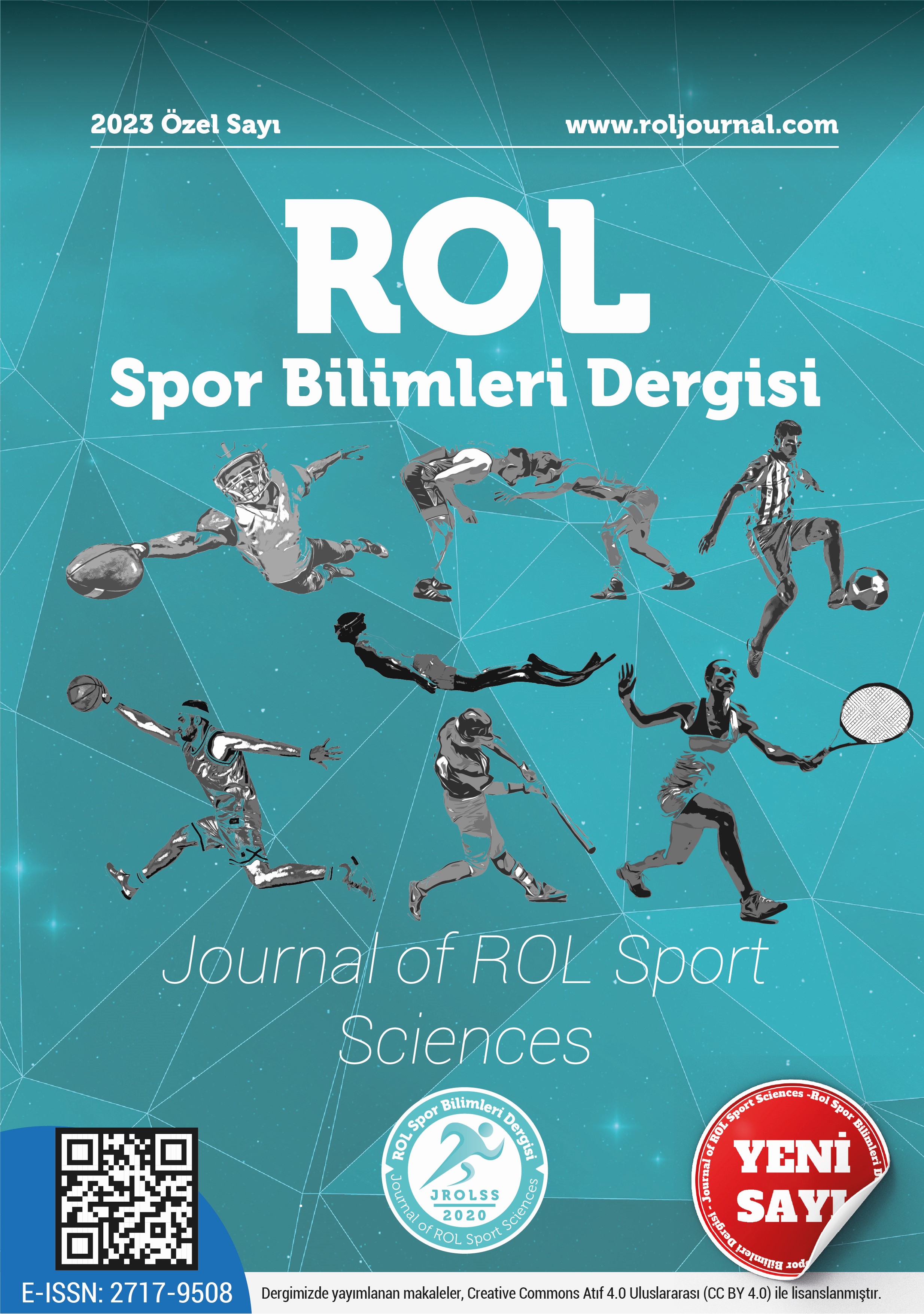Examining the relationship between body image flexibility of ballroom dancers and folk dancers and appearance-related social media consciousness
DOI:
https://doi.org/10.5281/zenodo.8405315Keywords:
Body image flexibility, psychological flexibility, social mediaAbstract
In this study, it was aimed to examine the relationship between body image flexibility of ballroom dancers and folk dancers and appearance-related social media consciousness in terms of various variables. In the study, the relational survey model, which is one of the quantitative research methods, was used. "Personal Information Form", "Body Image Flexibility Scale (BIBS)" and "Appearance-Related Social Media Consciousness Scale (ARSMBS)" were used as data collection tools. The research group consisted of a total of 200 dancers from Gazi University Paired Dance Sports Ensemble and Gazi University Folk Dance Ensembles. In the analysis of data; t-Test were used to determine the relationship between the variables, and Pearson Correlation analysis was used to determine the relationship between the scales. According to the results obtained from the research data, a moderate and significant relationship was found between the participants' body image flexibility and Appearance-Related Social Media Consciousness. Among the participants who constitute the study group of the research, the BIF of the folk actors was found to be higher than that of the hall dancers. A significant difference was found between the answers given by the participants to other variables and the BIF. It can be said that the fact that the participants use social media more frequently and for various purposes due to their social status and interactions in their environment influences the increase in ARSMC. A significant difference was found between the participants' other variables such as gender and the frequency of daily use of social media and ARSMC.
References
Adair, C. (1992). Women and dance: Sylphs and sirens. Bloomsbury Publishing.
Arkin, L. C. (1994). Dancing the body: Women and dance performance. Journal of Physical Education, Recreation & Dance, 65(2), 36-43.
Best, P., Manktelow, R., & Taylor, B. (2014). Online communication, social media and adolescent wellbeing: A systematic narrative review. Children and Youth Services Review, (41), 27-36.
Büyüköztürk, Ş., Çakmak, E. K., Akgün, Ö. E, Karadeniz, Ş., & Demirel, F. (2016). Bilimsel araştırma yöntemleri. Pegem Akademi.
Cash, T. F. (2004). Body image: Past, present, and future. Body Image, 1(1), 1-5.
Cohen, R., Newton-John, T., & Slater, A. (2017). The relationship between Facebook and Instagram appearance-focused activities and body image concerns in young women. Body Image, (23), 183-187.
Fardouly, J., Diedrichs, P. C., Vartanian, L. R., & Halliwell, E. (2015). Social comparisons on social media: The impact of Facebook on young women's body image concerns and mood. Body Image, (13), 38-45.
Fardouly, J., Diedrichs, P. C., Vartanian, L. R., & Halliwell, E. (2018). Social comparisons on social media: The impact of Facebook on young women's body image concerns and mood. Body Image, (26), 38-45.
Fredrickson, B. L., & Roberts, T. A. (1997). Objectification theory: Toward understanding women's lived experiences and mental health risks. Psychology of Women Quarterly, 21(2), 173-206.
Harrington, H. (2020). Consumer dance identity: the intersection between competition dance, televised dance shows and social media. Research in Dance Education, 21(2), 169-187.
Hayes, S. C., Luoma, J. B., Bond, F.W., Masuda, A., & Lillis, J. (2006). Acceptance and commitment therapy: Model, processes and outcomes. Behavior Research and Therapy, (44), 1–25.
Holland, G., & Tiggemann. M. (2016). A systematic review of the impact of the use of social networking sites on body image and disordered eating outcomes. Body Image, (17), 100-110.
İzgiman, S. (2014). Kabul ve kararlılık terapisi. Pinhan.
Jarry, J. L., & Ip, K. (2005). The effectiveness of stand-alone cognitive-behavioural therapy for body image: A meta-analysis. Body Image, 2(4), 317-331.
Karasar, N. (2005). Bilimsel araştırma yöntemleri. Nobel.
Kashdan, T. B., & Rottenberg, J. (2010). Psychological flexibility as a fundamental aspect of health. Clinical Psychology Review, 30(7), 865-878.
Kassing, G. (2007). History of dance: an interactive arts approach. Human Kinetics.
Koç A., Gökler, M. E., & Bilgehan T. (2019). Üniversite öğrencilerinde sosyal medya bağımlılığı ve takıntılı özçekim davranışının sosyal medya kullanım sıklığı bakımından karşılaştırılması. Yeni Symposium, 57(4), 15-20.
Lewallen, J., & Behm-Morawitz, E. (2016). Pinterest or thinterest?: Social comparison and body image on social media. Social Media Society, 2(1),
Linardon, J., Anderson, C., Messer, M., Rodgers, R. F., & Fuller-Tyszkiewicz, M. (2021). Body image flexibility and its correlates: A meta-analysis. Body Image, (37), 188-203
Manago, A. M., Graham, M. B., Greenfield, P. M., & Salimkhan, G. (2008). Self-presentation and gender on MySpace. Journal of Applied Developmental Psychology, 29(6), 446-458.
Morgan, G. A., Leech, N. L., Gloeckner, G. W., & Barrett, K. C. (2004). SPSS for introductory statistics: Use and interpretation. Psychology Press.
Öngören, B., Durdu, Z., Dongaz, Ö. İ., Bayar, B., & Bayar, K. (2021). Görünümle ilişkili sosyal medya bilinç ölçeğinin Türkçe uyarlaması: Geçerlik ve güvenirlik çalışması. Karya Journal of Health Science, 2(2), 33-38.
Perloff, R. M. (2014). Social media effects on young women’s body image concerns: Theoretical perspectives and an agenda for research. Sex Roles, 71(11-12), 363-377).
Puhl, R. M., & Heuer, C. A. (2009). The stigma of obesity: A review and update. Obesity, 17(5), 941.
Sandoz, E. K., Wilson, K. G., Merwin, R. M., & Kellum, K. K. (2013). Assessment of body image flexibility: The body image-acceptance and action questionnaire. Journal of Contextual Behavioral Science, 2(1), 39-48.
Silberstein, L. R., Striegel-Moore, R. H., Timko, C., & Rodin, J. (1988). Behavioral and psychological implications of body dissatisfaction: Do men and women differ?. Sex roles, (19), 219-232.
Tiggemann, M., & Slater, A. (2013). NetGirls: The Internet, Facebook, and body image concern in adolescent girls. International Journal of Eating Disorders, 46(6), 630-633.
Tylka, T. L., & Wood-Barcalow, N. L. (2015). The Body Appreciation Scale-2: Item refinement and psychometric evaluation. Body Image, (12), 53-67).
Uslu, M. (2013). Halk oyunları çalışmalarının üniversite öğrencilerinin psiko-sosyal gelişimlerine etkisi. Akademik Bakış Uluslararası Hakemli Sosyal Bilimler Dergisi, (39), 1-15.
Downloads
Published
How to Cite
Issue
Section
License
Copyright (c) 2023 Journal of ROL Sport Sciences

This work is licensed under a Creative Commons Attribution 4.0 International License.

